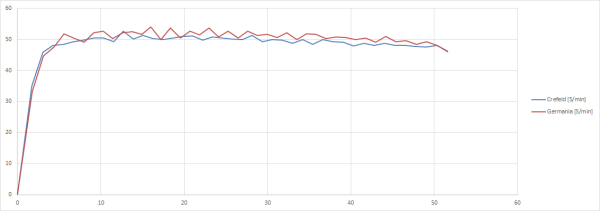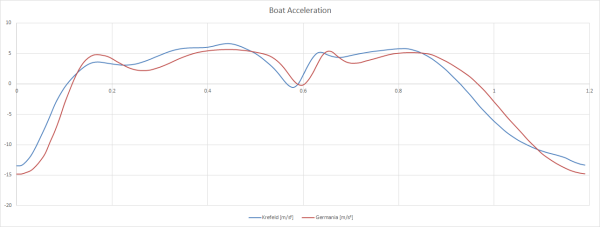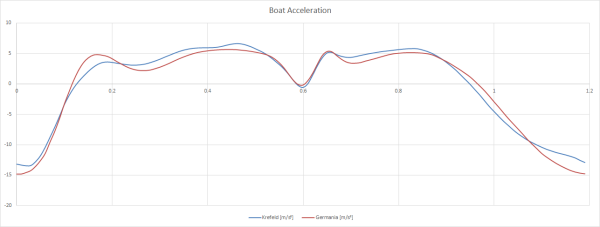Rowing Championsleague 2014 Finals Race Analysis
Rowing in Motion supported the finals of the Rowing Championsleague, a new international 350m sprint event in the 8+ where some of the worlds best European Club and University eights competed in a 1:1 knock out system to determine the fastest crew. The finals saw entries from the Netherelands, Great Britain, Hungary, Poland, Czcech Republic, Denmark, Switzerland and Germany. The crews were nominated by their national federations through a series of qualifier regattas which resulted in a very high level of quality racing.
We built an interactive live online results service for the Champions League finals that kept participants, visitors and the regatta officials always on top of race results and the next upcoming 1:1 races. It was also our pleasure to equip the two boats competing in the men’s final with a Rowing in Motion System to measure and analyze the race.
Using two smartphones, we recorded the races using our Rowing in Motion App and immediately afterwards uploaded the data to Rowing in Motion Analytics, our web based analysis tool and database which we then used to create the following analysis.
The Crews
Two crews dominated the competition throughout the mens tournament: Frankfurter RG Germania and Crefelder RC. These two crews are no strangers to 350m sprint rowing, in fact they are the two winning teams of the German Ruder Bundesliga (the national 350m sprint league) and they have fought many close battles throughout the 2014 season with Crefelder RC coming slightly ahead at the finals one weak prior. With the Frankfurt crew keen for a revenge over the closely missed national title, the final between the two crews promised to be very interesting.
Here are the statistics from the official weighing prior to racing (crew including cox):
- Frankfurter RG Germania: 810 kg
- Alexander Ohl de Mello, Markus Brich, Manuel Beyer, Rüdiger Lösel, Max Hinkel, Max Gottwald, Jens Raab, Ivan Saric, Dominik Thierbach
- Crefelder RC: 760kg
- Marc Benger, Larus Melka, Moritz te Neues, Mathias Keulen, Moritz Koch, Michael Naß, Lars Henning, Matthias Simons, Dirk Marterer, Paul te Neues, Kristof Wilke, Denise Kins
Reading through the crew names you may notice that Crefelder RC has had high profile support from Kristof Wilke, 2012 Olympic Champion in the M8+ for Germany.
The Race
Here’s the official broadcast of the race, feel free to take a look to get an impression of the two crews (the race starts at 1:40 is just a mere 50 seconds!).
The crew from Crefeld had a slightly faster start but Frankfurt managed to get ahead by a canvas over the next 30 strokes. Frankfurter RG Germania finished first in 0:47.99 and 45 strokes while Crefelder RC finished second in 0:48.49 and 44 strokes.
Strokerate
 We can see that Crefeld had a slightly faster start with higher strokerates while Germania achieved and maintained a higher maximum strokerate throug the rest of the race. Average Strokerate Germania: 50.28, Crefeld: 49.01. Both crews show a very slight decline in strokerates towards the finish.
We can see that Crefeld had a slightly faster start with higher strokerates while Germania achieved and maintained a higher maximum strokerate throug the rest of the race. Average Strokerate Germania: 50.28, Crefeld: 49.01. Both crews show a very slight decline in strokerates towards the finish.
These extremely high strokerates are clearly about 10 strokes/min higher than the average strokerates we see in 2000m races which are at 39.2 (see the August 2014 BioRow Newsletter).
Boat Acceleration
Much more interesting than comparing strokerates is a look at boat acceleration. The difference in boat acceleration between the two crews is clearly visible (both crews sampled at 50 Strokes/min).
The two crews have some very different rythms as we can see by the “phase-shift” between the two graphs. This “phase-shift” comes from a difference in the drive/recovery ratio as the Crefeld Crew seems to have a slightly shorter drive with a longer recovery phase at 50 strokes/minute. In fact, this is a result of Crefeld having a much longer “approach” towards the catch (a longer recovery) with where the maximum negative acceleration (which we use to mark the start of a stroke) occurs very late into the catch. The drive/recovery for Crefeld is
The graphical representation of aligning the strokes on the finish makes it a lot easier to see these differences that I will describe in the following, so I manually aligned the graphs towards the finish. Keep in mind the difference between the drive/recovery time ratio though.
Recovery and Catch
Crefeld has a slightly longer catch duration of 0.35 seconds compared to 0.34 seconds of Germania, which maintains boat speed for longer in the recovery through steady pulling on the stretcher into the catch but pays for this with a harder “hit” at the catch resulting in a higher maximum negative boat acceleration.
This is the result of two different “pulling” rythms on the stretcher during the recovery. We can see clearly that Crefeld maintains a higher boat acceleration during recovery by pulling (and accelerating) the boat more heavily away under the crew. For the Germania boat, this is not as extreme with a more “gentle” start into the recovery (if you can call 0anything gentle at 50 strokes/min 🙂 ).
During the catch, we can then see a steeper rise in boat acceleration for Germania (catch efficiency 129,2 vs 126.0 m/s³), hinting at possibly better bladework (see Improve your stroke – hit the catch ).
Drive Phase
Even though Germania shows a clear cut “drive hump” (the first peak in boat acceleration after the catch), we need to keep in mind that the bottom of the hump (the first local minimum following the hump) is still at a very good 2.19m/s². Crefeld on the other hand shows a much less intensive hump and significantly less peak acceleration for the first hump. On the other hand, Crefeld maintains a significantly higher boat acceleration throughout the later parts of the driving phase, hinting at either a higher physical capability or better crew synchronization/matching.
The higher acceleration by Crefeld during the remaining drive phase could explain the shorter drive time and consequently lower drive/recovery ratios, though we would need to know the two crew’s actual stroke-length to determine that for sure (Crefeld may just be rowing shorter or with different levers).
Recommendations Suggestions
What could the two crews change to improve? As always, this is a very difficult question and can effective improvement can only be learned through experimentation. That’s why I’ll call this section sugggestions and not recommendations. Rowing is complex and while one thing may work for one crew in particular, it may not work for others. So here are some suggestions based on my personal experience of working with boat acceleration data, and as always, open for discussion.
FRG Germania
The FRG Germania crew could try to improve the second part of their drive phase. The Crefeld crew demonstrates that a higher acceleration in this phase is possible either due to higher physical ability or due to better crew synchronization, matching or individual arms/legs/trunk connection. I wouldn’t discard the possibility that a change in rigging might affect this as well.
Crefeld RC
The Crew from Crefeld RC could try working on a more “gentle” begin of the recovery. This may sound counter-intuitive but a slower but steady pulling at the begin of the recovery combined with a “hard and fast” catch may actually help achieve higher stroke-rates and closing the gap to FRG Germania. Crefeld appears currently to spend too much time “standing” on the stretcher at the catch and reversing the direction of the fast crew movement that resulted from the heavy pulling.
Concluding Words
There are many aspects to rowing race performance. If we can say one thing for sure about the two crews, it’s that their performance is very close despite the obvious differences in their acceleration profiles. Throughout the season of the national sprint league in Germany we have seen some 1:1 races between them won by either of the crews.
In the case of this final, the difference in fininsh times was remarkable though with a clear 0.5s advantage for FRG Germania. I am inclined to attribute this to a more efficient approach into the catch and the resulting higher stroke frequencies this “hard and fast” catch enabled the crew to maintain through the race.
Can’t wait for next years races!



The comparisons of the curves (and knowing the results!) are interesting, since Crefeld actually spent more of the time during the stroke with a higher acceleration than Frank than a few certain points (last part of the recovery into the catch and during the first peak, it seems to suggest that those parts of the stroke are the most important parts of the stroke and would be the parts to really make sure to get right (so make sure you have a large drive hump and accelerate into the catch)
What was the comparison of the other metrics, for example the stroke efficiency? That is one value I have struggled a little to understand as my own testing suggests that stroke efficiency is actually less important and that ive seen sessions where the efficiency has gone down, but boat speed has gone up (due to improved catch times/acceleration)